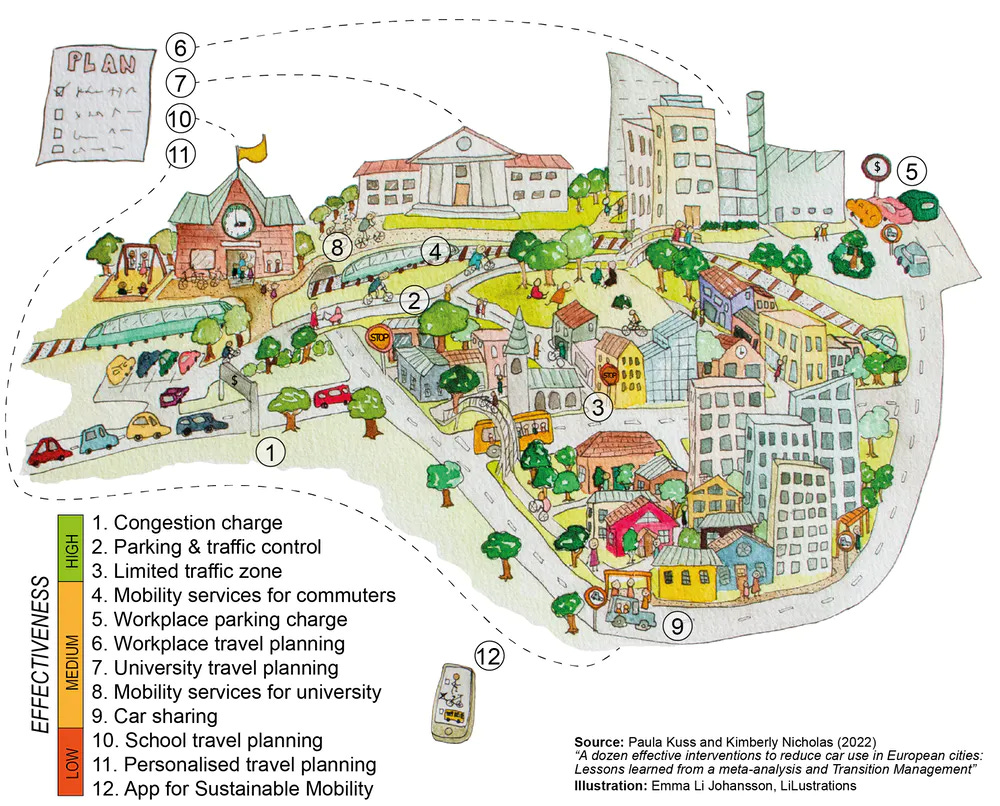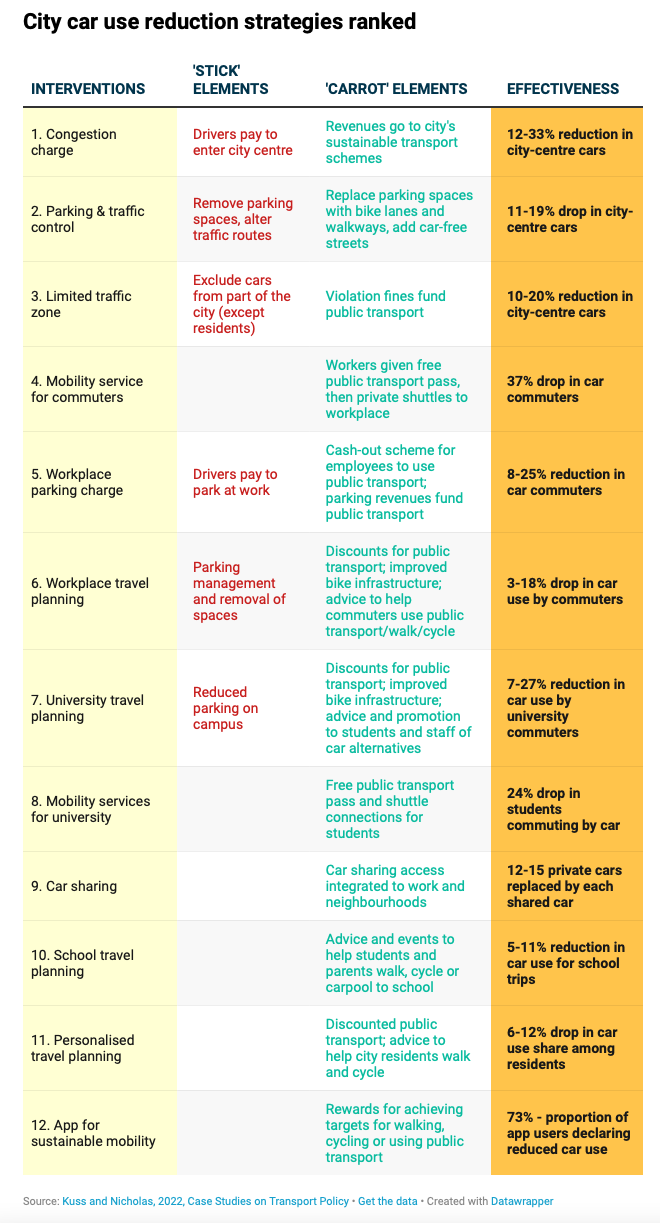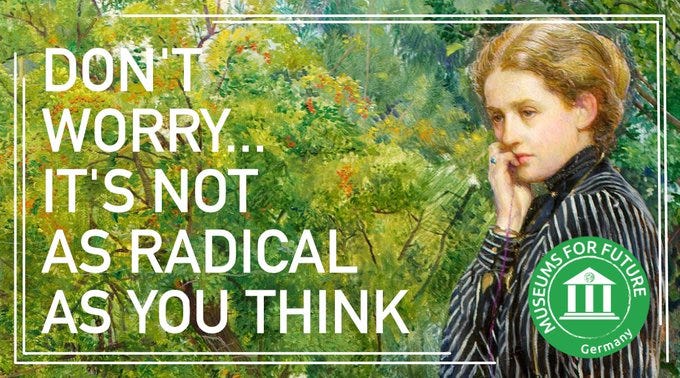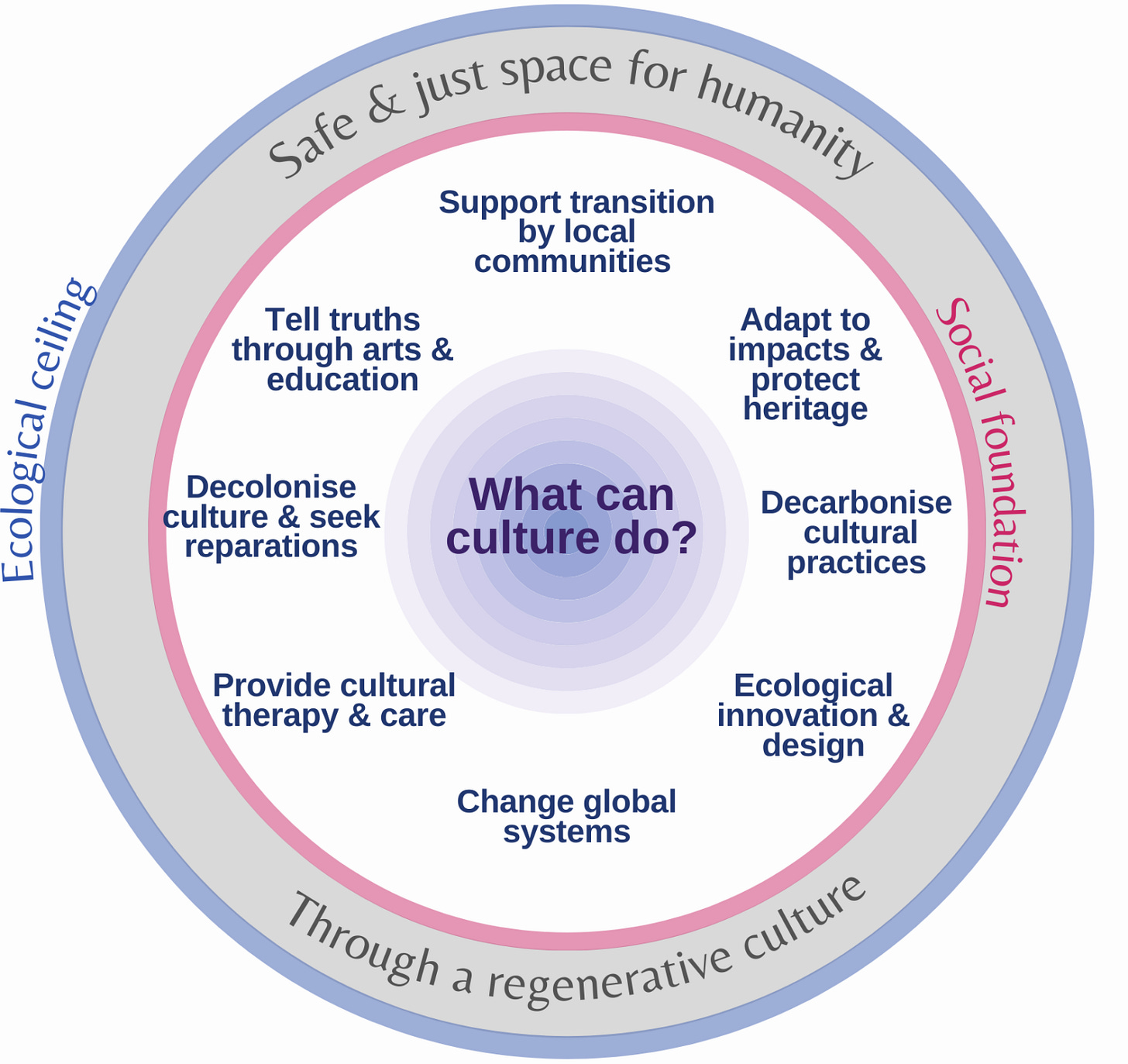Move Over, Cars! 12 Ways to Prioritize People
Facts: 12 ways to free cities from cars / Feelings: Squirming over climate infighting / Action: Climate action gets GLAM (Galleries, Libraries, Archives, & Museums)!
Hi friends! I’m really glad you’re here. Recent news has me thinking how much I appreciate this We Can Fix It community. Among many other reasons, I’m glad it’s not dependent on a specific platform. If Substack evaporates, I have your emails and my writing, and can recreate it somewhere else. So thanks for being here, and please keep an eye out for a survey coming soon so I can get to know you and how I can serve you better. <3
And if you’re new, join the squad here:
On to the facts, feels and action!
Facts: 12 ways to free cities from cars
As a We Can Fix It reader, you know that, for the average household in North America or Europe, cars are the biggest climate polluter.
But good news! Dozens of cities have already put in place measures that worked to demonstrably reduce cars and support sustainable mobility, creating more space and cleaner air for people.
In a study led by the wonderful Paula Kuss (developed out of her masters’ thesis!), from screening nearly 800 cases, we identified 12 ways that have *already worked* to reduce cars in cities.
Here are the 12 measures, ranked by effectiveness, in artistic format! (It would make a great coffee mug, don’t you think??)

And here are the 12 measures in wonk-friendly table format!

Key takeaway 1: Effective measures combine sticks and carrots.
You already know that getting people to drive less is what’s needed to reduce emissions, and carrots alone don’t work to get people out of cars.
Our analysis shows that effective measures need to address driving and parking reduction and restriction as an explicit goal (the red “sticks” column above)— and then use the space freed and the money generated to expand and improve walking, biking, and public transport (the green “carrot” column above).
Many people on Twitter said, “You forgot bike lanes!”
No, I didn’t. They’re part of #2, 6, and 7, for example. It’s just that bike lanes ALONE weren’t found effective to reduce cars. Carrots AND sticks.
Key takeaway 2: Local city government must lead.
We found 75% of the effective measures were led by local government, often in collaboration with employers, universities, or transport providers.
But! We know politicians don’t hear enough from their constituents supporting bold climate policies.
So: please go right ahead and forward this email to your local city leaders, and ask them to implement evidence-based car reduction policies.
Don’t forget your favourite:
mayor
city council members
city and transportation planners
cycling, walking, and sustainable mobility groups
disability rights groups (see this excellent report from Possible on how reducing unnecessary cars benefits those who truly need them).
You can also tag your leaders in my posts about this research on Twitter, LinkedIn, or Instagram. Or share our piece in The Guardian on the measures and the cities that have put them into practice. :)
And if you’re hungry for even MORE, read what my editor called “an evidence-based rant against cars” for The Conversation, where I explain why:
electric cars don’t solve the problems of cars
cars today exacerbate social inequalities
focusing explicitly on reducing cars, not only increasing sustainable mobility, is necessary
governments should stop subsidising cars and driving
policies have to change to overcome the playing field now tilted towards cars
Excited to hear how you use these measures to make your city better!
Feelings: Squirming Over Infighting
Here’s a feeling Climate People don’t talk about much: discomfort, distress, or worse over internal group dynamics where people who share a goal of a fast and fair transition to a fossil-free world fight with each other. Eeeeek.
Of course, we need to get the facts straight, and robust discussion about strategies are welcome. Of course, it’s important to listen with humility to people operating from good faith.
But I’ve been noticing a big uptick in infighting, blame, and defensiveness on Climate Twitter, and it really bums me out. A circular firing squad doesn’t seem like the way to build the world I want to live in. It also takes time and energy away from the actual work we need: dismantling the systems of power that lock in exploitation, and rebuilding them towards regeneration.
My armchair analysis is that everyone is overstretched personally, and climate scientists are exhausted from screaming into the void for decades, and things in the world are not going well, and people are lashing out at each other. Which is understandable, but not great.
It makes me wonder: What would lead to more generative and fruitful conversations? How can Climate People express concerns, doubts, worries, or observations in a way that leads to support, reflection, and mutual learning, rather than personal judgment, defensiveness, or criticism? Is the nature of social media exacerbating this problem? What kind of forum or platform would let people exchange ideas more constructively?
I don’t have the answers to these questions, but I would love to hear what you think in the comments below!
Action: Team Climate gets GLAM (Galleries, Libraries, Archives, and Museums)!
You know who is fired up about climate action? Museums!!
I heard a lot of great ideas at the Spring Meeting of Swedish Museums this week. The whole meeting was themed around the role museums can play in the climate crisis. (Can you get your next professional conference to adopt a climate theme??)
If you work in the arts, culture, with museums, or visit museums, take some inspiration from the points below!
And if not— how can you adapt these ideas to your sector??
Museums for Future
Matilda Eriksson of Museums for Future gave a fabulous talk where she invited museums to ask themselves how they can serve society in the climate crisis. (A good question for all of us!!)
She shared four points from the Declaration of Museums for Future:
1. Support climate strikes
Matilda offered reassurance of nonviolence and solidarity, and suggested museums start by asking youth climate activists “How can we support each other with our unique talents and resources?” (Again, great climate convo starter generally.)

2. Communicate to the public
Museums can use their collections to draw attention to the climate crisis, including by putting #ObjectsOnStrike or pointing out problematic ties with fossil fuels.
3. Transform our institutions to be part of the solution
Museums can focus on their own operations, both practically in terms of eliminating emissions, and how they work to support a fast and fair transition.
4. Raise awareness in our networks
Our relationships are powerful. Museums for Future urged museums to “use our voices to spread awareness about the necessity of immediate climate actions” among museums, employees, management, and decision-makers.
How can you adapt these four points for your sector??
Making Culture Regenerative— Bridget McKenzie
Bridget McKenzie of Climate Museums UK gave an inspiring talk. She suggests:
Be “Possitopian”- while “A techno-utopian future view is creating a dystopian reality”, Climate Museums UK aims to be neither utopian nor dystopian, but rather to “approach future thinking by expanding the cone of the possible future”. A critical 21st century skill!!
Bridget argued the cultural sector should reimagine its role, to help people cope with the traumas of the Anthropocene (Earth, biosphere, climate, human, and intersectional), feel possibilities, enable them emotionally to take effective action, and develop eco-capacities.
Bridget offered a vision for museums to contribute to regenerative culture and embed themselves in Kate Raworth’s Doughnut Economics framework, by for example decolonising culture, decarbonising cultural practices, and using arts for truth-telling and cultural therapy and care. This framework has been taken up by Culture Declares emergency.

From the United Nations to Your Museum
Henry McGhie of Curating Tomorrow has an excellent series of free guides, like Action for Climate Empowerment, that translate the United Nations Sustainable Development Goals into suggestions for what galleries, libraries, archives and museums (GLAM!) can do:
as a sector,
at particular institutions,
and as individual workers,
with suggested metrics.
It’s super practical and clear. I would love to see more guides like this for every sector!
Awareness through Art
Matilda Eriksson shared a powerful collaboration between WWF and Museo del Prado, to digitally alter paintings from the collection to draw attention to climate impacts in billboards across Madrid.


Gut punch, right?
What examples of climate art have you seen? Please share in the comments below!
Parting Tidbits
Listen: I spoke to Carlton Reid on The Spokesmen podcast on why climate scientists are getting desperate (5:00), why building great bike lanes isn't the solution to reducing cars (13:50), how to make car reduction politically palatable (29:45, 38:20), & why all cars need to be fossil-free but the best car is... a bicycle (51:20, 46:00). Enjoy!
Read: A book I got to read last year and blurb is finally out, and it’s so good! Return to Nature, by Emma Loewe, is an antidote to burnout and a gentle invitation to expansive possibilities for awe, restoration, and gratitude right outside your front door, through accessible rituals, simple mindset shifts, and solid practical advice on how we can better care for nature in our everyday lives as consumers and citizens.
Take care friends! Get outside and enjoy April. Tulips are blooming here in Lund!
xo,
Kim




In the discussion on the Volts podcast which introduced me to your excellent work, you referenced some research/evidence you'd found a) about the best ways to un-car cities that are also the most politically feasible and b) about measures that work best in more rural areas and in North America. Could you bring some of them together in a future post? Having moved from London, UK to a car-dominated low density city struggling intermittently to change, I am desperate to find ways to get the message across!
Appreciating hearing from you again. Your commitment to informing us. Keeping these concerns up front. Deepening my understanding about what needs to happen. I live in one of the biggest cities in Massachusetts, USA. Imagining how this plan could play out. Downtown. But also in the neighborhood I live in south of it. This information is so thoughtfully put together. Will pass it on to some leaders I know. What I might add, about how climate activists are relating is this. There needs to be a whole different level of connecting going on. I think having a covenant for how they speak to each other would help. An agreement. So there would be guidelines for communicating with each other that were simple yet clear. When you do this, how you treat others, is just as important as what you say to others. Sometimes this just happens over time. Like with my neighbor across the street, whom I have known for 30 years. I feel blessed that we honor a way of speaking to each other, without ever having to create a formal covenant. Kimberly, I think it's critically important what you bring up about infighting. And really, part of addressing Climate Change, is about changing the way we treat each other. How we show up for each other. So it is so relevant. Feelings are big. They matter.